
Illán de Vacas is a town in the province of Toledo, in Castile–La Mancha, Spain. The surface area of the municipality is 9 km², it has a total population of 1 inhabitant, making it the least populated municipality in Spain.

Sea pens are colonial marine cnidarians belonging to the order Pennatulacea. There are 14 families within the order; 35 extant genera, and it is estimated that of 450 described species, around 200 are valid. Sea pens have a cosmopolitan distribution, being found in tropical and temperate waters worldwide, as well as from the intertidal to depths of more than 6100 m. Sea pens are grouped with the octocorals, together with sea whips (gorgonians).

Limonium is a genus of 120 flowering plant species. Members are also known as sea-lavender, statice, caspia or marsh-rosemary. Despite their common names, species are not related to the lavenders or to rosemary. They are instead in Plumbaginaceae, the plumbago or leadwort family. The generic name is from the Latin līmōnion, used by Pliny for a wild plant and is ultimately derived from the Ancient Greek leimon.
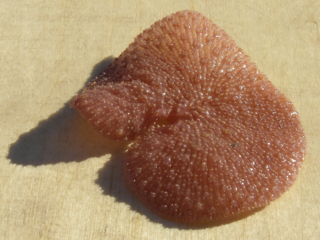
The sea pansy, Renilla reniformis, is a species of colonial cnidarian in the family Renillidae, part of an octocoral subclass of Anthozoa that inhabit an expansive range of environments. It is native to warm continental shelf waters of the Western Hemisphere. It is frequently found washed ashore on North East Florida beaches following northeasterly winds or rough surf conditions. It also can often be found living intertidally completely buried in the sand. Its predator is the striped sea slug, Armina tigrina.

The narrowtail catshark is a catshark of the family Scyliorhinidae, found off the coasts of Honduras and Nicaragua, between latitudes 18° N and 10° N, at depths between 190 and 410 m. It can grow up to a length of 35 cm (14 in). The reproduction of this catshark is oviparous.
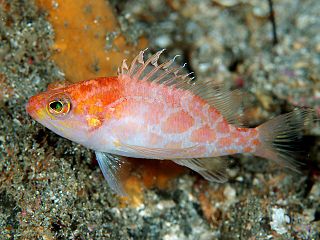
Plectranthias is a genus of ray-finned fish in the subfamily Anthiinae, part of the family Serranidae, the groupers and sea basses. They are found in the Atlantic, Indian and Pacific Ocean.
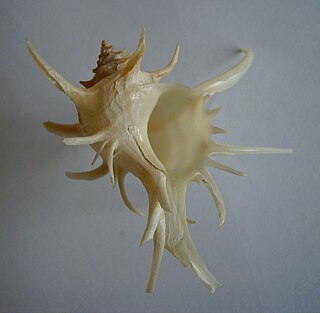
Poirieria is a genus of large predatory sea snails, marine gastropod molluscs in the family Muricidae, the rock snails.
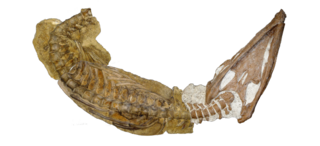
Brachauchenius is an extinct genus of pliosaurid that lived in North America during the Late Cretaceous.
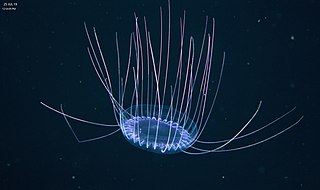
Solmissus, or dinner plate jellyfish, is a genus of hydrozoans. Its species are unique among cnidarians in that they actively hunt for prey as opposed to passively waiting for plankton to pass by. They are found in the deep waters of Monterey Bay, California. They are most likely to be found in the deep sea, mid water. They grow to be 20 cm (7.9 in) in diameter. These hydrozoans feed on gelatinous zooplankton, including salps and doliolids, ctenophores, jellyfish, and copepods.. However, Solmissus may be limited to feeding on soft-bodied prey by the type of nematocysts on their tentacles (Mills).
Eochelone is an extinct genus of sea turtle from the late Eocene. It was first named by Dollo in 1903. Its type species is E. brabantica.

Coelenterazine is a luciferin, a light-emitting molecule, found in many aquatic organisms across eight phyla. It is the substrate of many luciferases such as Renilla reniformis luciferase (Rluc), Gaussia luciferase (Gluc), and photoproteins, including aequorin, and obelin. All these proteins catalyze the oxidation of this substance, an reaction catalogued EC 1.13.12.5.

Corynactis is a genus of colonial anthozoans similar in appearance to sea anemones and in body format to scleractinian stony corals. These animals are cnidarians in the family Corallimorphidae. Large unidentified polyps of this genus feed on the crown-of-thorns seastar Acanthaster planci and may help control the crown-of-thorns population.

Aulactinia is a genus of sea anemones in the family Actiniidae.

Briareidae is a family of corals, a member of the phylum Cnidaria.

Anemonia is a genus of sea anemones belonging to the family Actiniidae.

Renilla koellikeri is a species of sea pen that has been reported from the southern coast of California, including Santa Barbara, California.

Renilla muelleri is a species of sea pansy. It has been reported from the Gulf Coast of the United States, notably the Florida panhandle, but is also reported from the eastern coast of South America. It is thought to be a euryhaline littoral species, found to a depth of up to 150 meters.
Ramirezia is a genus of sea anemones of the family Acontiophoridae. It currently includes only one species.















